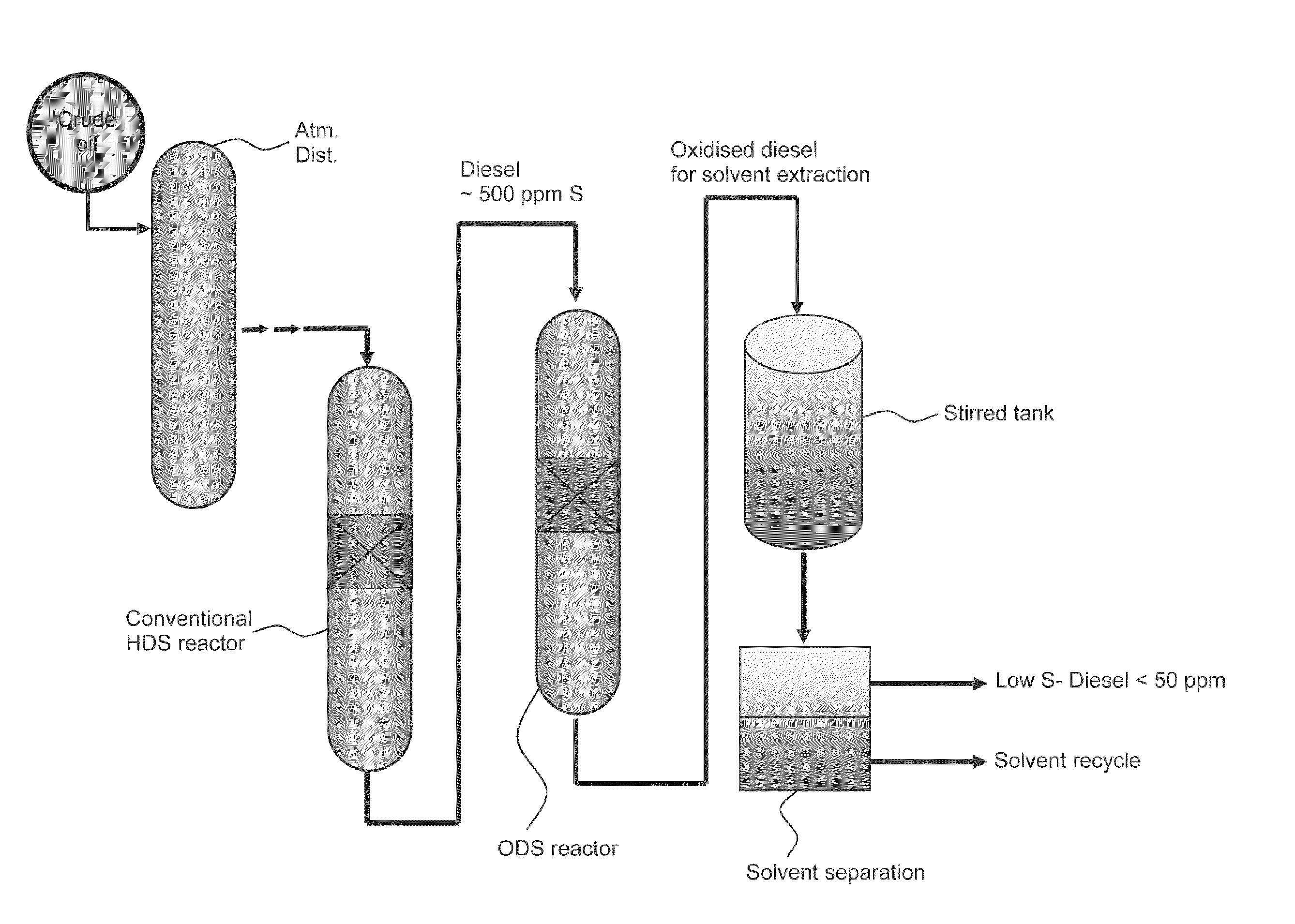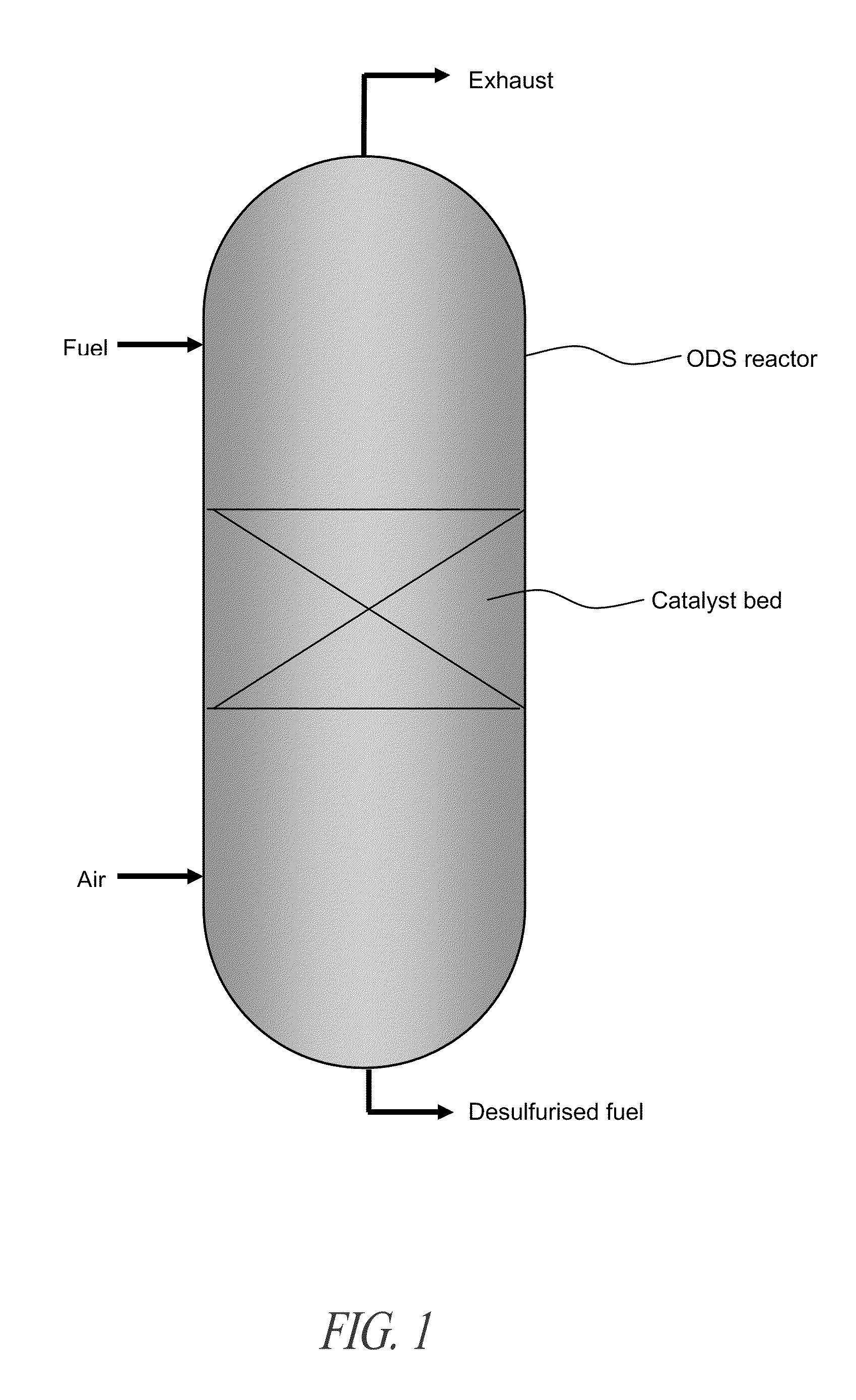Novel process for removing sulfur from fuels
- Summary
- Abstract
- Description
- Claims
- Application Information
AI Technical Summary
Benefits of technology
Problems solved by technology
Method used
Image
Examples
example 1
Catalyst Preparation and Characterization
[0082]The catalysts to be prepared comprise transition metal oxides and porous support with high specific surface area have been prepared by impregnation using incipient wetness method. 10 g of γ-alumina pellet (diameter=3-4 mm, length=6-10 mm, specific surface area (Sg)=370 m2 / g, specific pore volume ranged from 0.82 ml / g to 0.87 ml / g) was impregnated with cobalt nitrate and / or manganese acetate aqueous solutions. The total metal oxides loading with respect to γ-alumina ranged from 2 to 13 wt %. The impregnated sample was left on the roller which was set at 25 rpm for approximately 18 h to obtain better dispersion. The sample was then dried at 120° C. in the oven for 18 h for removal of the water content. The dried sample was calcined in a static furnace at 550° C. for 5 hours with a ramp of 5° C. / min. Powder X-ray diffraction (XRD) showed that the catalysts were amorphous and that no distinguishable crystallographic properties could be obse...
example 2
Oxidative Desulfurization with Solvent Extraction Using a Model Diesel
[0083]DBT and / or 4-MDBT were chosen to prepare model diesel by dissolving them in n-tetradecane with a total sulfur content of 500-800 ppm. In most of the experiments, sulfur content in the model diesel was introduced by adding only DBT. In the remaining experiments, both 4-MDBT and DBT were added. The oxidation experiments were carried out in a stirred batch reactor.
[0084]In a two-necked round bottom flask, 10.0 ml of model diesel containing approximately 500 ppm of sulfur underwent oxidative reaction in the presence of 20-30 mg of the catalyst (diameter=3-4 mm, length=6-10 mm). The mixture was magnetically stirred to ensure a good mixing and bubbled with purified air at flow of 60 ml / min. The reactions were carried out at a temperature range of 90-200° C. The optimum temperature for this specific set up was found to be 130° C. at which the oxidation of the model compounds occurred successfully with insignificant...
example 3
Oxidative Desulfurization and Solvent Extraction on Real Diesel
[0090]A) Solvent Extraction on Diesel without Oxidative Treatment
[0091]Four 25.0 ml samples of untreated diesel was mixed with the polar organic solvents AcN, DMF, NMP and MeOH, respectively, in order to determine the effect of solvent extraction on sulfur compounds present in untreated fuel. After extraction by the respective polar solvents, the sulfur content of the diesel was measured by X-ray florescence (XRF). Untreated diesel had sulfur content of 370-380 ppm before extraction was carried out (measured by XRF using s-standard calibration curve). The GC-AED analysis of the sulfur content in the diesel is shown in FIG. 8A. The results in FIG. 8B show that among the solvents tested, NMP was most efficient in extracting sulfur compounds present in untreated fuel.
B) Oxidative Treatment Using Co3O4 and MnO2 Catalysts Supported on γ-Alumina Followed by Solvent Extraction
[0092]In a two-necked round flask, 100 ml real diese...
PUM
 Login to View More
Login to View More Abstract
Description
Claims
Application Information
 Login to View More
Login to View More - R&D
- Intellectual Property
- Life Sciences
- Materials
- Tech Scout
- Unparalleled Data Quality
- Higher Quality Content
- 60% Fewer Hallucinations
Browse by: Latest US Patents, China's latest patents, Technical Efficacy Thesaurus, Application Domain, Technology Topic, Popular Technical Reports.
© 2025 PatSnap. All rights reserved.Legal|Privacy policy|Modern Slavery Act Transparency Statement|Sitemap|About US| Contact US: help@patsnap.com



